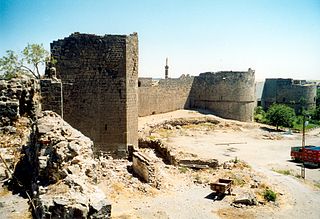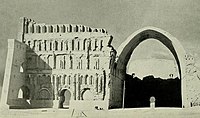
The Assyrian Church of the East, officially the Holy Apostolic Catholic Assyrian Church of the East, is an Eastern Christian church that follows the traditional christology and ecclesiology of the historical Church of the East. It belongs to the eastern branch of Syriac Christianity, and employs the Divine Liturgy of Saints Addai and Mari belonging to the East Syrian Rite. Its main spoken language is Syriac, a dialect of Eastern Aramaic, and the majority of its adherents are ethnic Assyrians.

The Chaldean Catholic Church is an Eastern Catholic particular church in full communion with the Holy See and the rest of the Catholic Church, with the Chaldean Patriarchate having been originally formed out of the Church of the East in 1552. Employing the East Syriac Rite in Syriac language in its liturgy, it is part of Syriac Christianity by heritage. Headquartered in the Cathedral of Mary Mother of Sorrows, Baghdad, Iraq, since 1950, it is headed by the Catholicos-Patriarch Louis Raphaël I Sako. It comprises 628,405 (2017) ethnic Assyrians living in northern Iraq, with smaller numbers in adjacent areas in northeastern Syria, southeastern Turkey and northwestern Iran, a region roughly corresponding to ancient Assyria. There are also many Assyrians-Chaldeans in diaspora in the Western world.

Jīlū was a district located in the Hakkari region of upper Mesopotamia in modern-day Turkey.
Dioceses of the Church of the East, 1318–1552 were metropolitan provinces and dioceses of the Church of the East, during the period from 1318 to 1552. They were far fewer in number than during the period of the Church's greatest expansion in the tenth century. Between 1318 and 1552, the geographical horizons of the Church of the East, which had once stretched from Egypt to China, narrowed drastically. By 1552, with the exception of a number of East Syriac communities in India, the eccesiastical jurisdiction of the Church of the East was confined to its original heartland in northern Mesopotamia.

Metropolitanate of Beth Garmai was an East Syriac metropolitan province of the Church of the East between the fifth and fourteenth centuries. The region of Beth Garmai is situated in northern Iraq, bounded by the Little Zab and Diyala Rivers and centered on the town of Karka d'Beth Slokh. Several bishops and metropolitans of Beth Garmaï are mentioned between the fourth and fourteenth centuries, residing first at Shahrgard, then at Karka d'Beth Slokh, later at Shahrzur and finally at Daquqa. The known suffragan dioceses of the metropolitan province of Beth Garmaï included Shahrgard, Lashom (ܠܫܘܡ), Khanijar, Mahoze d'Arewan, Radani, Hrbath Glal (ܚܪܒܬܓܠܠ), Tahal and Shahrzur. The suffragan dioceses of 'Darabad' and 'al-Qabba', mentioned respectively by Eliya of Damascus and Mari, are probably to be identified with one or more of these known dioceses. The diocese of Gawkaï, attested in the eighth and ninth centuries, may also have been a suffragan diocese of the province of Beth Garmaï. The last known metropolitan of Beth Garmaï is attested in the thirteenth century, and the last known bishop in 1318, though the historian ʿAmr continued to describe Beth Garmai as a metropolitan province as late as 1348. It is not clear when the province ceased to exist, but the campaigns of Timur Leng between 1390 and 1405 offer a reasonable context.
The Metropolitanate of Merv was an East Syriac metropolitan province of the Church of the East, between the fifth and eleventh centuries, with several known suffragan dioceses.
The Metropolitanate of Rai was an East Syriac metropolitan province of the Church of the East, between the eighth and twelfth centuries. The province of Rai had a suffragan diocese for Gurgan.

The Metropolitanate of Shemsdin, created after the 1552 schism in the Church of the East, the predecessor to the Assyrian Church of the East, was the second most important ecclesiastical province of the Qudshanis patriarchate after the province of the patriarch himself. The metropolitans or matrans of Shemsdin traditionally took the name Hnanishoʿ and lived in the Shemsdin village of Mar Ishoʿin the sub-district of Rustaqa. There were around twelve metropolitans of Shemsdin between the sixteenth and twentieth centuries, most of whom were chosen by hereditary succession. The last metropolitan of Shemsdin, Mar Yosip Khnanisho died in Iraq in 1977, and the office of mutran lapsed on his death.
Diocese of Berwari was an East Syriac diocese of the Church of the East, existing between the sixteenth and twentieth centuries and covering the region of Berwari.

The Diocese of Amid (Diyarbakir) was a diocese or archdiocese of the Chaldean Church from the sixteenth to the twentieth century. From at least the 13th century the city of Amid had been part of the Diocese of Maiperqat of the Church of the East; following the schism of 1552 it became the seat of its own diocese in the Chaldean Church.
The Diocese of Tirhan was an East Syriac diocese of the Church of the East, within the central ecclesiastical Province of the Patriarch. The diocese is attested between the sixth and fourteenth centuries.

The Diocese of Marga was an East Syriac diocese of the Church of the East. The diocese was included in the metropolitan province of Adiabene, and is attested between the eighth and fourteenth centuries. Towards the end of the thirteenth century the name of the diocese was changed to 'Tella and Barbelli'.
Diocese of Kashkar, sometimes called Kaskar, was the senior diocese in the Church of the East's Province of the Patriarch. It see was in the city of Kashkar. The diocese is attested between the fourth and the twelfth centuries. The bishops of Kashkar had the privilege of guarding the patriarchal throne during the interregnum between the death of a patriarch and the appointment of his successor. As a result, they are often mentioned by name in the standard histories of the Nestorian patriarchs, so that a relatively full list of the bishops of the diocese has survived.
Diocese of Adarbaigan was one of the classical East Syriac dioceses of the Church of the East. The diocese, attested between the fifth and eighth centuries, was centred on the town of Ganzak and was included in the metropolitan province of Adiabene.
The Patriarch of the Church of the East was a patriarch of the Church of the East (410-1552), seated in Seleucia-Ctesiphon.
The Diocese of Shigar and Beth ʿArabaye was an East Syriac diocese of the Church of the East in the metropolitan province of Nisibis, centred on the town of Sinjar. The diocese is attested between the sixth and fourteenth centuries.
The Diocese of Salakh was an East Syriac diocese of the Church of the East in the metropolitan province of Adiabene, attested in the eighth and ninth centuries.
Diocese of Armenia was an East Syriac diocese of the Church of the East between the fifth and fourteenth centuries. The diocese served members of the Church of the East in Armenia, and its bishops sat at Halat. The diocese is last mentioned in 1281, and probably lapsed in the fourteenth century during the disorders that attended the fragmentation of the Mongol empire.
The Schism of 1552 was an important event in the history of the Church of the East. It divided the church into two factions, of which one entered into communion with Rome becoming part of the Catholic Church at this time and the other remained independent until the 19th century. Although the Eliya line, which emerged as a result of this schism, did eventually enter into communion with Rome, various Spiritual Christian sects with their origins in the Church of the East emerged as a result of this schism. Ironically, the Shimon line whose entry into full communion with Rome caused this schism, in fact became independent again by the 17th century. The circumstances of the 1552 schism were controversial at the time and have been disputed ever since.







